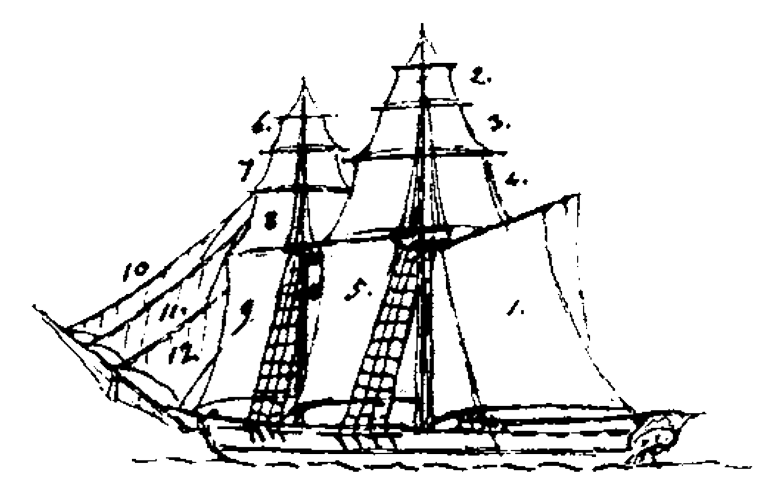June 7, 1832
7 June: Early in the morning, calm and rain. The ship is very wet. The sails flap slackly without wind. After eight o’clock, a light breeze from the south. All the sails are quickly set, including several studding sails, and finally we make about 4 knots, [Page 1:9] as the log indicates. Many jellyfish and Portuguese men-of-war also float past. Lone petrels hover about us. A porpoise. From now on the ship makes about 4 to 5 knots.

The American names for the sails are as follows: 1. trysail. 2. royal. 3. main topgallant sail. 4. main topsail. 5. mainsail. 6. fore royal. 7. fore topgallant sail. 8. fore topsail. 9. foresail. 10. flying jib. 11. jib. 12. fore topmast staysail. 13. spencer. (We do not see much of this last sail in the drawing; it is located between the foremast and the mainsail on a yard that joins the mast only on one side, just like the trysail.)
The best practical book for seamen, in which all nautical topics are treated, is The New American Practical Navigator, being an epitome of navigation etc. By Nathaniel Bowditch, New York, 1821.
At noon the sky was overcast; the altitude of the sun could not be taken. Temperature 11 3/4°R ⟨[58.4°F, 14.7°C]⟩, temperature of the water 11 1/2°R ⟨[57.9°F, 14.4°C]⟩. In the afternoon, rain; from the south the weather was foggy or hazy. Individual Portuguese men-of-war and sea birds. One no longer noticesjellyfish; they have withdrawn into the deep because the wind has become rather brisk since ten o’clock this morning and the sea is rougher. Toward evening more rain. At about five o’clock a ship, the brig Ann from Halifax in Nova Scotia, coming from Trinidad and bound for Ireland. It sails past us, then follows us, and sends a boat with a letter to America. At eight in the evening the wind shifts to the west and becomes unfavorable. The sails are changed. Our longitude 31°51' west.


